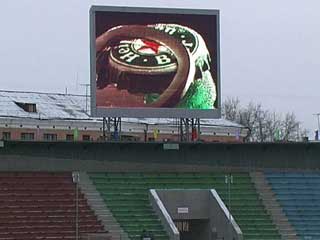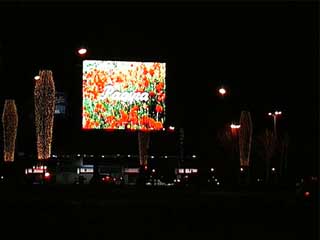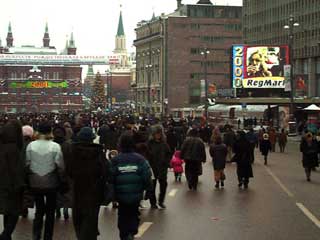Everyday miracles: Advanced electronic screens made affordable!
The Editorial Board of our magazine decided to devote this article to an important event that happened in Moscow in early April 2002. The first ever upgrade of an electronic screen from lamp into LED technology was performed. The technology and procedures have been developed by the Russian engineering team and can be ranked as the state-of-the-art feat in the area of large electronic screens and displays. Previously most, if not all, innovations came from the USA, Japan and China.
The contribution of Russian engineers may affect all basic approaches to this new area of informational engineering (outdoor video systems) and will doubtlessly influence on the “Outdoor Video and TV” trend as a whole. What follows is an interview with Sergey Dobrynin, Deputy Managing Director, “ATV Outdoor Systems”, the company that has developed the above technology.
Mr. Dobrynin, what is new in the technology developed by your engineering team?
I would even specify: 1) What is new for the users and audiences; 2) What new approaches your technology offers to the developers of large electronic advertising video systems the world over?
I should say that our team works not so much to gratify our scientific ambitions or achieve higher sales figures. We work for the audience and users trying to make our systems as attractive and user-friendly as possible. Therefore, in solving engineering, scientific and purely technical tasks we strive to preserve the optimal correlation between best performance, large sizes and affordable price. Essentially, our technological solutions allow users to choose between optimized products in terms of price-size-performance ratio and easily adapt our screens to the specific purposes and peculiar local conditions.
It is for this reason that we place special emphasis on:
- Identifying the optimal correlation between dimensions, prices, and functions of our screen advertizing systems;
- Improving performance of existing systems by adding new functional capabilities at minimal cost. The electronic outdoor screen systems are a part of fast growing and developing high-tech area. It is therefore essential to not only create a modern system but to incorporate possibilities of future upgrades so that the system could be modified as the electronic industry comes up with new products and solutions;
- Facilitating repair and maintenance on these outdoor screen systems, general monitoring of each unit, making screens easy to wash (considering high dust and pollution content in city air);
- Providing operators of these systems with user-friendly functions that help to maintain large electronic screens and improve their advertising effect on the general public.
Regarding your second question about system manufacture: The world is not perfect. Several times we have encountered more than ungentlemanly competition methods. There were cases when people would come to work for us for a couple of years and then leave with the idea to independently clone our conceptual solutions.
Modern electronics is developing so fast that only a consolidated and dedicated team of specialists in different areas can hope to keep abreast with all innovations, solve various problems from electrical and electronic to steel structuring and assembly, from low-level programming to creating comprehensive computer animation and other numerous engineering, technical and software tasks. Therefore, this is not the time and place to reveal all our principal know-how solutions. However, we can proudly report what has already been accomplished and is being used:
- Many Western and Russian outdoor electronic screen manufacturers build their screens from modules of 40-50 kg. Handling these modules is extremely difficult. Therefore, we have developed screen modules of only 4 kg, while all other units within a screen are not heavier than 7 kg. As a result, maintenance of our screens is much easier while their technical parameters have drastically improved.
- As far as I know, our company is the first to introduce a single technological process for the manufacture of lamp and LED screens. We can take lamp screens (with different light modules) and conduct full upgrade to a LED technology with minimal expenses and in shortest time possible.
- We have introduced a fully integrated user-friendly control system which is being constantly modernized and turn operation of the screen into a simple, even trivial task.
 |
 |
| Giant outdoor lamp screen at Krasnoyarsk stadium | Giant outdoor advertizing lamp screen in Kazakhstan |
Mr. Dobrynin, our magazine repeatedly wrote about two main approaches to control systems - oriented towards analogous and digital video information transfer. What is your company's approach?
We work with both trends. We also pay special attention to integrating Internet-technology and new outdoor screen network solutions, both in software and hardware. For example, on a huge outdoor lamp screen in Krasnoyarsk we managed to broadcast live signal from TV cameras and superimpose subtitles and other special effects in real time. At the same time, the Ethernet channel allowed us to effectively control the system and interrupt live broadcasting for advertising commercials when necessary.
On our next large outdoor advertizing lamp screen in Kazakhstan we introduced another option: the screen was connected to the control center via Ethernet channel that was capable to control the screen, download new files via FTP-protocol, receive log-reports and conduct live video broadcasting simultaneously.
On a new advertizing LED screen in Moscow we have introduced one more option: remote wireless control of brightness, contrast and saturation, as well as remote control of scheduling and reporting. As you see, we are constantly working on modernizing our electronic screens, include new options and functions and facilitate control of these fairly complicated systems.
 Large LED advertizing screen in Moscow
Large LED advertizing screen in MoscowEveryone boasts of advantages. Can you say a few words about shortcomings of your screens?
Every complex system has advantages and disadvantages. Our screens are not the exception. If electronic screens were easy to build and operate, probably by now the cities would have only electronic screens instead of static billboards.
However, high-tech areas present a lot of problems for developers. For example, TV sets are being manufactured for over 50 years now - and still nobody can build TV screens over 72 inch. The best result for rear-projection screens is 1.5-2 meter. Personal computers are at the forefront of technology - but still they are pestered with problems. There is no good and reliable operation system, Windows is notorious for its loopholes, although the best software developers are working on it for over 40 years.
The electronic outdoor advertising is only 10 year old. Russia has only a handful of specialists in this area. For us it is very satisfying to know that our engineering team is doing well, comes up with fundamental approaches which become the leading trends in the world. The result that was achieved on our last Moscow LED screen is much better than we expected. We have introduced too many innovations at once - many of them untried - and nothing has malfunctioned. Naturally, this is not the end of the road. We still have to polish many of the technological solutions as well as to continue developing new ones.
What can you say about your competitors?
We have already answered that in our previous interview. It is worth mentioning that in the area of large electronic screens (over 50 square meters) only the USA, Japan, China and Korea have achieved noticeable advances. Today Russia can also be used in this list. We have resolved the whole complex of problems and created technology that significantly improves parameters of these outdoor screen systems (price, dimensions, and technical characteristics). There no analogues to our approach in the world.
In the area of mid-sized electronic screens (up to 4x6 meters), the approaches of all leading world manufacturers are quite similar. Cluster technologies that were very popular only a few years ago, are getting replaced by other solutions now. They are difficult for maintenance and are inconvenient for long-term life.
Many companies are trying to reduce pixel pitch and achieve excellent results for small systems of 12-20 sq. meters. But in the range of large electronic screens (50-70 sq. meters and above) there are few engineering teams capable of manufacturing advanced highly reliable product. It is most gratifying that our Russian team was able to develop a competitive system comparable to the best samples of these products in the world, such as Panasonic, Saco and Daktronics.





